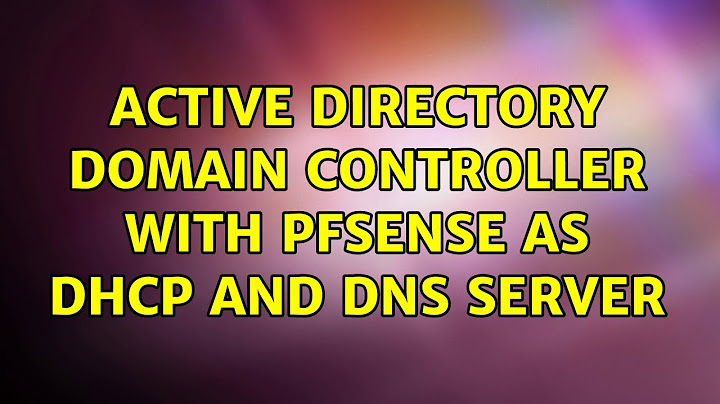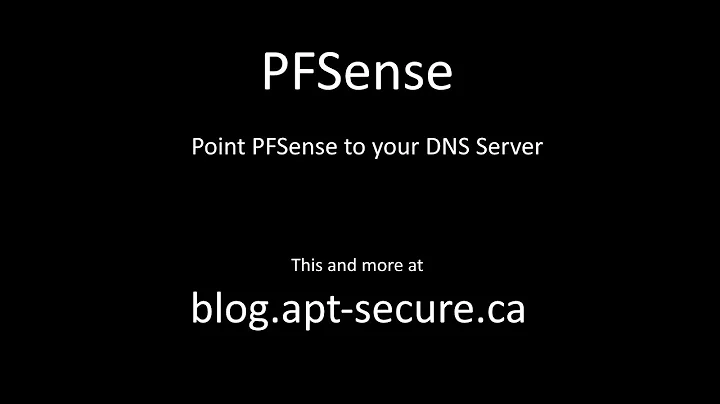Active Directory Domain Controller with pfSense as DHCP and DNS server
Active Directory doesn't require DHCP, but it does require DNS. You'd need to set up some sort of DNS for it to work (Microsoft, BIND, etc). Most people use their Active Directory server as their DHCP and DNS server as well, though, as the integration of the three makes things easier.
I'd set up your server as AD/DHCP/DNS, disable the DHCP and DNS forwarding on pfSense, and tell your MS DNS server to take care of the DNS forwarding.
Related videos on Youtube
Marc05
I like to understand at least a little about all aspects of computers; consequently, I'm a noob programmer (C++ / HTML+CSS+JQuery) with a kick-ass desktop.
Updated on September 18, 2022Comments
-
Marc05 over 1 year
I've read some conflicting posts, so hopefully I can get a clear answer.
I have pfSense running as a DHCP server and DNS Forwarder. I'd like to try out Active Directory as a Domain Controller at home using Windows Server 2012 R2. Would I have to set up Server 2012 R2 as a DHCP/DNS server as well for AD to work properly?
-
Marc05 almost 10 yearsThanks for the advice, but it'd be nice to know why this would be best practice. From the little that I've found, it's possible to have a separate DNS server (e.g. pfSense, if that can even be done - I'm not too familiar with it).
-
Marc05 almost 10 yearsThanks, this led me to find another post: "You can achieve the goal by setting DNS forwarder on all your AD integrated DNS servers, so that the DNS queries that can’t be resolved by your AD DNS server will be forwarded to this separate server." I'll probably have Windows Server 2012 R2 do all of it though.
-
 DarkMoon almost 10 yearsWell, DNS forwarders are what most companies use. For instance, we have our internal DNS server that takes care of our internal domains, but we don't setup and maintain DNS entries for every domain on the Internet. We set up our DNS server to "forward" requests to an external server for non-internal domains, so we only have to worry about the internal ones. Our DNS server then caches the reply for a while, so if someone else requests the same DNS entry, it doesn't have to go out and get it again.
DarkMoon almost 10 yearsWell, DNS forwarders are what most companies use. For instance, we have our internal DNS server that takes care of our internal domains, but we don't setup and maintain DNS entries for every domain on the Internet. We set up our DNS server to "forward" requests to an external server for non-internal domains, so we only have to worry about the internal ones. Our DNS server then caches the reply for a while, so if someone else requests the same DNS entry, it doesn't have to go out and get it again. -
 DarkMoon almost 10 yearsWell, it looks like mainly, you need to ensure that you add a few SRV records for service location. If you Google "pfsense dns active directory", you should find a few posts explaining what's needed to make this work.
DarkMoon almost 10 yearsWell, it looks like mainly, you need to ensure that you add a few SRV records for service location. If you Google "pfsense dns active directory", you should find a few posts explaining what's needed to make this work.




![Active Directory, DNS & DHCP Roles Installation & Configuration on Server 2022 [Step by Step Guide]](https://i.ytimg.com/vi/31Uh7WPDd9E/hqdefault.jpg?sqp=-oaymwEcCOADEI4CSFXyq4qpAw4IARUAAIhCGAFwAcABBg==&rs=AOn4CLB-e1rNUFQ7CKwIFInZNJ9cW1FalQ)